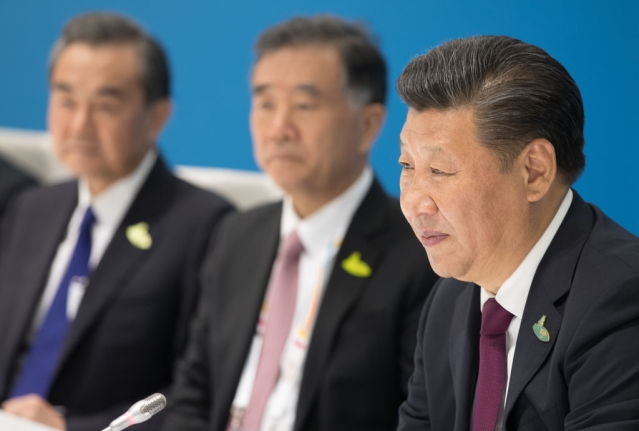
SNAPSHOT
With the 19th Congress of the Chinese Communist Party coming up later this month, it appears that Xi Jingping wants to project that even after Doklam, it is China that is dictating terms to India.
Chinese envoy to India, Luo Zhaohui, said a few days ago – “We should turn the old page and start a new chapter with the same pace and direction. We should dance together. We should make one plus one eleven. China is the largest trading partner of India. We have made a lot of progress at the bilateral level, as well as in international and regional affairs”. Whether Luo had coordinated his words with China’s People’s Liberation Army (PLA) is not certain because the very first opportunity for China to walk the talk has actually been spurned by the PLA.
According to the 11 April 2005 Protocol, and the one reinforced on 17 January 2012, there are five points along the Sino-Indian border, where ceremonial border personnel meetings, as confidence building measures, were to be conducted twice a year on the respective national or army days of India and China. It is yet unclear whether these meetings actually took place on 01 August 2017 (PLA Day) or on 15 August 2017 (India’s Independence Day) at the height of the Doklam standoff. There have been reports of such meetings being in progress, according to a report on 15 August 2017, and subsequently denied. What is, however, abundantly clear is that on 1 October 2017, China’s National Day, there was no such invite from the Chinese side; that is a clear four weeks after the 72-day-long Doklam standoff ended. What do the signals portend in strategic terms?
The 19th Congress of the Chinese Communist Party (CCP) is slated to commence from 18 October 2017. Besides the second five-year term for President Xi Jinping, there is much at stake in this meeting. Xi intends to extend his hold to an unprecedented ‘beyond five years’ and retain chairmanship of the Central Military Commission (CMC) thus allowing him clear control over the armed forces. Besides this, the Congress will take stock of the position of China vis-a-vis its last stated objectives. That essentially means foreign, defence and economic policies will all be on the anvil.
How important are Sino-Indian relations in this context? On the face of things North Korea, South China Sea, US-China relations, Japan and the One Belt One Road (OBOR) appear to be the issues at hand, in no particular order of priority. The China-India border issue is really not such a priority although it is a part of the OBOR issue. However, two events have made China more tentative about Sino-Indian relationship, not entirely sure how to take it further. First is India’s decision to stay away from OBOR conference in Beijing in May 2017 and second the Doklam standoff. It is quite clear that China pushed the Doklam agenda beyond a point in the hope of scoring points in terms of intimidation of India; it was probably hoped that it would give Xi an advantage during the 19th Congress. It did not work out as it had been envisaged, with India’s more than robust and bold response plus refusal to be intimidated by the war of words unleashed by the Chinese propaganda machine.
To now display conciliatory gestures towards India through border personnel meetings and business as usual could send wrong signals about the PLA’s military and psychological capability under Xi. In fact, the Indian and international media, which have been feting India on the handling of Doklam, would probably go overboard in projecting India’s robust diplomacy in relationship to China. That is surely not something easily digestible to the Xi camp, which has competition within the Congress.
Two other issues may be in the mind of Xi Jinping camp. First of these is India-US relations, which seem to be getting stronger by the day. This is an area China is extremely wary of and uncertain of handling. A mere counter by establishing a stronger relationship with Pakistan is not sufficient because a strong Indo-American strategic partnership is not aimed at the Afghanistan-Pakistan region alone but also the Indian Ocean and Pacific regions, which matter much more to China for its resource security. Second is the emerging Indo-Japanese relationship, which after the recent visit by Prime Minister Shinzo Abe to India now seems more firmly embedded.
With the Doklam type of intimidation having failed, China remains uncertain about how to handle India. The BRICS summit and the communique condemning transnational terror temporarily restored order in the Sino-Indian relationship but Doklam has created a problem regarding calibration of China’s robust intimidation. The inability to create the right psychological noise in spite of the much touted 25-year policy of preparing the PLA and other forces for war under ‘informationised’ conditions must have come as a bit of a dampener after the Indian leadership could read the signals correctly and temper its response.
Thus further strategy in dealing with India is going to be a challenge. China does not wish to lose any further face and will thus approach issues with India tentatively. Border personnel meetings tend to convey business as usual which China certainly does not perceive as the situation. It has to be surer of itself on this, and also convey to India that there are many domains in which it will keep it engaged to prevent the latter from emerging more confident after Doklam.
No comments:
Post a Comment